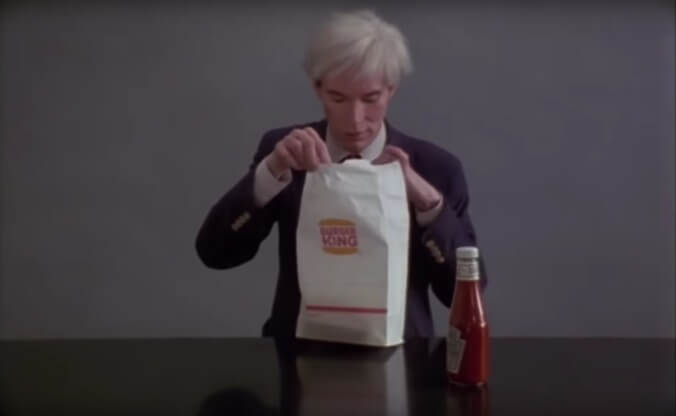Sorry, Burger King, Andy Warhol actually preferred McDonald's
Last night, in what reads as decades-late payback for Andy Warhol famously reclaiming brand imagery in his art, Burger King used a video of the deceased artist for their own Super Bowl advertising. Through footage taken from Jørgen Leth’s 1982 documentary 66 Scenes From America, viewers were shown Warhol munching on a hamburger before being prompted to #EATLIKEANDY (the strange compound term “eatlike,” we must assume, is Danish.)
Though there’s much to be said about the cultural ramifications of Warhol’s image being repurposed as an expensive-to-air fast food ad, the first point to get to is a simple one: Andy Warhol would’ve rather eaten McDonald’s.
Comedy writer and fast food expert Bill Oakley, who you may remember from his similarly enlightening critique of the gilded White House UberEats order, took to Twitter with an explanation.
An article by Slate’s Matthew Dessem goes further into these details, highlighting an interview with Leth where the director explains how Burger King ended up getting used in a shoot the fast food company is now touting as representative of Andy’s burger preferences.
Dessem has helpfully provided a transcription of the relevant section. In Leth’s own words:
“ … Warhol was so aware of his own commercial value and he might refuse to appear with a certain product. So I took my precautions. When he saw the three hamburgers I had ordered, one from Burger King and two neutral products, he said, ‘Where’s the McDonald’s?’ I said we’d get one right away. ‘It’s the nicest design,’ he said. ‘Let’s not waste time on that. I’ll eat the Burger King.’ It was his choice. I hadn’t expected him to be so relaxed about the choice of product. But he preferred McDonald’s because they had the nicest design, in his very professional opinion. Burger King was okay, but he refused to work with the neutral ones.
So, as it turns out, to hashtag “Eat Like Andy,” as Burger King instructs, we should only settle for their food when McDonald’s isn’t readily available. Whether that’s a strong marketing position is for others to decide. As Oakley points out in the tweet below, maybe it’s enough for the rest of us just to revel in the weirdness of corporations advertising themselves based on weirdly recontextualized pop art that forces questions of ranking Big Burger’s output in the first place.
Warhol eats a second-rate burger; the snake eats its own tail.
[via Slate]
Send Great Job, Internet tips to [email protected]
